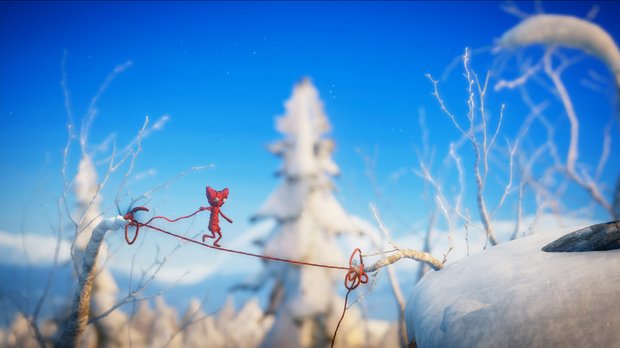Unravel ties together some delightful ideas, making it more than a cute platformer
It’s the yarn - not loveable hero Yarny - that’s the real star of Unravel. Its what makes this wonderfully whimsical platform puzzle game truly unique, and the thing that may save players from the frustrations of the genre. After all - the setting and ambiance of the whole game is so sedate, it simply wouldn’t be appropriate to have the person holding the pad to be tense. Let me explain.
As Yarny travels through the world - my demo shows off a back garden filled with old trees, windfall apples, and a pond - he leaves a trail of string behind him. Yeah, he’s literally unravelling as he walks and jumps, and you see him getting all skinny the further you go. According to the developers, yarn management gets more and more important later in the game - if you can’t unravel more, you physically can’t progress.

What that means is you have a trail of string behind you that is either used to solve puzzles or rewind progress. So, for example, there are fixed points in the environment (like nails), which allow you to hurl a yarn lasso, create a swing, and clear larger jumps. You can make bridges by fixing yarn at one point, then threading it to another, letting you move items over gaps, or spring up to higher points in the level. The real key to being great at Unravel is how you string (ahem) all these abilities together.
One example of a puzzle from my demo sees Yarny needing to cross a dry pond. It’s too far to jump or swing across. There are a bunch of apples nearby, but I can’t get them over the lip of the pond into the basin, so I create a string bridge that allows me to shift the fruit. Once all five apples are in the pond, I lasso the water pipe and fill up the bowl. The apples float to the top, creating a bridge, and I’m free to walk over it to the other side.

The real beauty, though, is that you can always use your yarn to climb back if you miss a jump or swing. Our hero just grabs the string and hoists himself back to the ledge. It’s a neat way of ensuring that - if you’ve climbed all the way up a tree, for example, and missed the last jump - you don’t need to repeat the same puzzles over and over.
Not that you’re likely to resent spending much time in Yarny’s world. It’s a beautiful, natural place to be, where the most fierce enemies are crabs that nip at your string, and the only real natural threat is water. Even if you do take a soaking, the checkpointing is super-generous, and Yarny will appear at the point you last fixed your string to something.

As with all games involving some kind of craft material, Unravel is precision designed to be adorable. At one point in my demo, Yarny tumbles down a steep slope, goes head over heals, then rubs his woolly head as he stands back up. He’s surprisingly emotive for such a simply designed character. Even when he ‘dies’ all you see is the screen getting blurry, so you don’t witness Yarny’s true distress.
Sign up to the GamesRadar+ Newsletter
Weekly digests, tales from the communities you love, and more
Sure, Unravel is a game about whimsy and natural beauty; a platformer with universal appeal and indie roots. But it’s also a smart, polished adventure game with the backing of a major publisher and a character that will likely sell a million pieces of cuddly merchandise. If the creators can tie all these threads together… Unravel could be a credible craft platformer (let’s face it, Yoshi's Wooly World and LittleBigPlanet 3 lean too heavily on the cute) that has a credible core inside that fluffy exterior.



